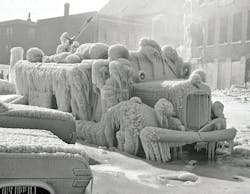Bill Noonan Fire Photographer, Boston Fire Department
What was the largest incident you ever responded to?
Commissioner Marty Pierce sent me to the Worcester Cold Storage fire in December 1999 where six firefighters died on Sunday, three days into the operation. Boston had sent units to assist in the operations. That was very impressive to watch and photograph the various aspects of the recovery. I was actually sent inside the shell of the building to photograph the remains for the Worcester FD Arson Squad. I will never forget that as the fire was still burning under us. I was sent two different days.
Among your duties in the Photo Unit, what were you assigned to photograph?
I covered all multiple-alarm fires, arson or fires of suspicious nature, promotions, accidents involving department apparatus or department property, evaluation of new equipment and some retirement nights, last night in the firehouse, etc. We also covered Fire Prevention incidents, such as poor housekeeping, etc.
What was the best day on the job?
A good day was when I got some good images — it could be a new piece of apparatus or a promotion of some people I knew. Every day I went to work was a good day. I have been extremely fortunate and worked with without a doubt some of the best bosses ever.
What was your worst day on the job?
The pier fire in Charlestown where my friend Lieutenant Steve Minehan died and two other firefighters were seriously injured. That was in June 1994.
My second worst day was Jan. 6, 1981 — three fires, four dead. At the first fire, it was a child in a three-decker in Dorchester in the early afternoon. The second was an eight-alarm fire on Arlington Street, two firefighters dead — Lieutenant Paul Lentini and Firefighter Jimmy Gibbons, both from Engine 37. Number three was a fire in the middle of the night in Dorchester where a woman died. At the Arlington Street fire, I used all cameras and strobes before they went dead because of dripping water. Everything had to be dried and re-charged. Many others tie for the third worst, such as the night with two hotel fires in March 1979, both arson and set by the same person.
What was the most spectacular job you ever photographed?
The Plant Shoe Fire in February 1976.
Photos of that fire were published in the first issue of Firehouse® in September 1976.
The Plant Shoe Fire occurred at a huge complex that became fully involved in fire. It was used by artists and other small manufacturing businesses. The night of the fire, it was warm with heavy rain. The next morning, the temperature dropped to below freezing. The photo of Engine 7's wagon was taken two days later (see page 92). The rig ran out of gas, but the chiefs were worried about the walls coming as some had collapsed, so the wagon was abandoned. The wagon was removed to the shop and eventually returned to service.
You have used several formats of cameras, black-and-white film, color film and now digital images. What's your favorite?
When I started, we used 2¼-by-3¼-inch film. I always carried a 35-mm camera with slide film. Eventually, we switched to all 35-mm and that was great, but I still miss my black-and-white film. I loved Kodak T-MAX film; it was very forgiving. Then, the city switched to all color, but I still carried a camera with T-MAX. The firefighters always loved the 8-by-10 black-and-white glossy photos. The images you can get with digital are incredible; if we had had this back 30 years ago, it would have really been something. My favorite would be black and white with digital a very close second.
What are your favorite pictures you have taken?
Some of my favorite photos are the "dirty faces," which were plentiful back in the "war years." I also think they look best in black and white. You can see that with digital and how people post them today in black and white.
Describe some of the days or nights when you were out the entire tour.
A couple of years ago, we had a multiple in the middle of the night; it went to three alarms. Soon after I arrived, I heard a firefighter yell that they thought they had a victim, but it was an animal, but a few minutes later while conducting the initial search of the third floor, they found two kids in a closet. As soon as it was safe, I made my way to the third floor to photograph the two victims, then there was a wait as this fire turned into an arson/homicide. It was tough to see those two kids. We were held over and I didn't get home until almost 2200 hours. A very long tour, but eventually there was a conviction. I like to think the photos helped with the conviction.
Some days, you just went from fire to fire to fire and when you went home you went right to bed. During the arson fires of the early 1980s, you were up all night long. One night I responded to four multiple-alarm fires after midnight. All were arson.
How do the troops like the group shots you take of them?
They love them, or at least they said they did.
Do you have a favorite type of photo you like to compose?
I always liked the photos of just one or two firefighters working, whether it be a firefighter on a ladder opening up, a nozzleman close up or two guys using the "Jaws" to free a trapped motorist.
